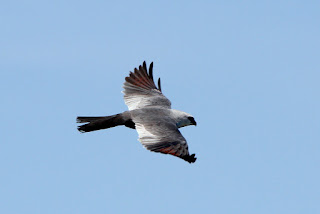by Ashley Studholme
 The low hum of the periodic cicadas signals more than “it’s time to mate,” for birds it signals “it’s time to feast.” Sitting on a deck in Lake Ridge, I watch as hawks to sparrows bounce in the treetops and zip through the air with cicada wings protruding from their bill. Chicks are being fed well this year!
The low hum of the periodic cicadas signals more than “it’s time to mate,” for birds it signals “it’s time to feast.” Sitting on a deck in Lake Ridge, I watch as hawks to sparrows bounce in the treetops and zip through the air with cicada wings protruding from their bill. Chicks are being fed well this year!
My parents and I were about an hour into an afternoon tradition that we started at the beginning of the pandemic...the Backyard Bird Count Happy Hour. The tongue-twisting aside, it’s why I have binos around my neck and a piña colada in my hand, the hour in “happy hour” has an implicit “at least.”
In particular, we were watching a pair of nesting Red-shouldered Hawks, who were meticulously and consistently running cicadas, snakes, and other tasty treats to feed their young - 2 chicks confirmed, little pale gray fluff balls that look little like their reddish-barred and keen-eyed parent.
Suddenly, out of the corner of my eye, I see the elegant flight of...Wait, what is that? My birding inexperience is showing, and I lose sight of this feathered air dancer behind the maple tree in the neighbor’s backyard.
It lands on a snag conveniently in a gap of the Maple canopy. Now, I got it! As I focus in with my binos, I hear the gasp slip from my dad’s lips, “Mississippi Kite!” I’m soaking in the color and shape of this magnificent creature - the black mask, gray hues transitioning from light gray on its head to dark on the wingtips, such contrast from the Red-shouldered I had been admiring all day.
Cicadas, of course, were on the menu! The gap in the canopy of the maple tunneled our vision and the rest of the world fell away.
The trance was short-lived. Streaking in from the right, one of the Red-Shouldered hawks decided that this backyard wasn’t big enough for the two of them. The Mississippi Kite bumped gracefully and flew off, last seen headed towards Old Bridge Rd.
“On the East Coast, the species first extended its known nesting territory from South Carolina into North Carolina in the 1970s and has steadily expanded its presence in that state ever since, especially the southeastern corner. In the summer of 1996, two adults skipped north over northeastern North Carolina and most of Virginia to establish the first known nesting site of the species in the Commonwealth in a suburban backyard in Woodbridge, Virginia”
Yup! That’s right, the first known breeding pair of Mississippi Kite wasn’t in southern Virginia, it was here in Prince William County!
They seem to hop around geographically as they expand their breeding ground, and it’s unclear what the driving factors are. We know that they tend to prefer nesting in taller, old-growth trees but have adapted to more fragmented landscapes. The combination of the suburban landscape and agricultural practices using shelterbelts has added more breeding options for them. Land-use change along with underlining environmental shifts due to climate change likely account for their breeding range expansion in recent decades.
Still, there’s more mystery than certainty. While these birds are fairly common in their range, more research is needed to better understand their unique traveling behavior and what that might mean for habitat conservation in our ever-changing environment.




No comments:
Post a Comment